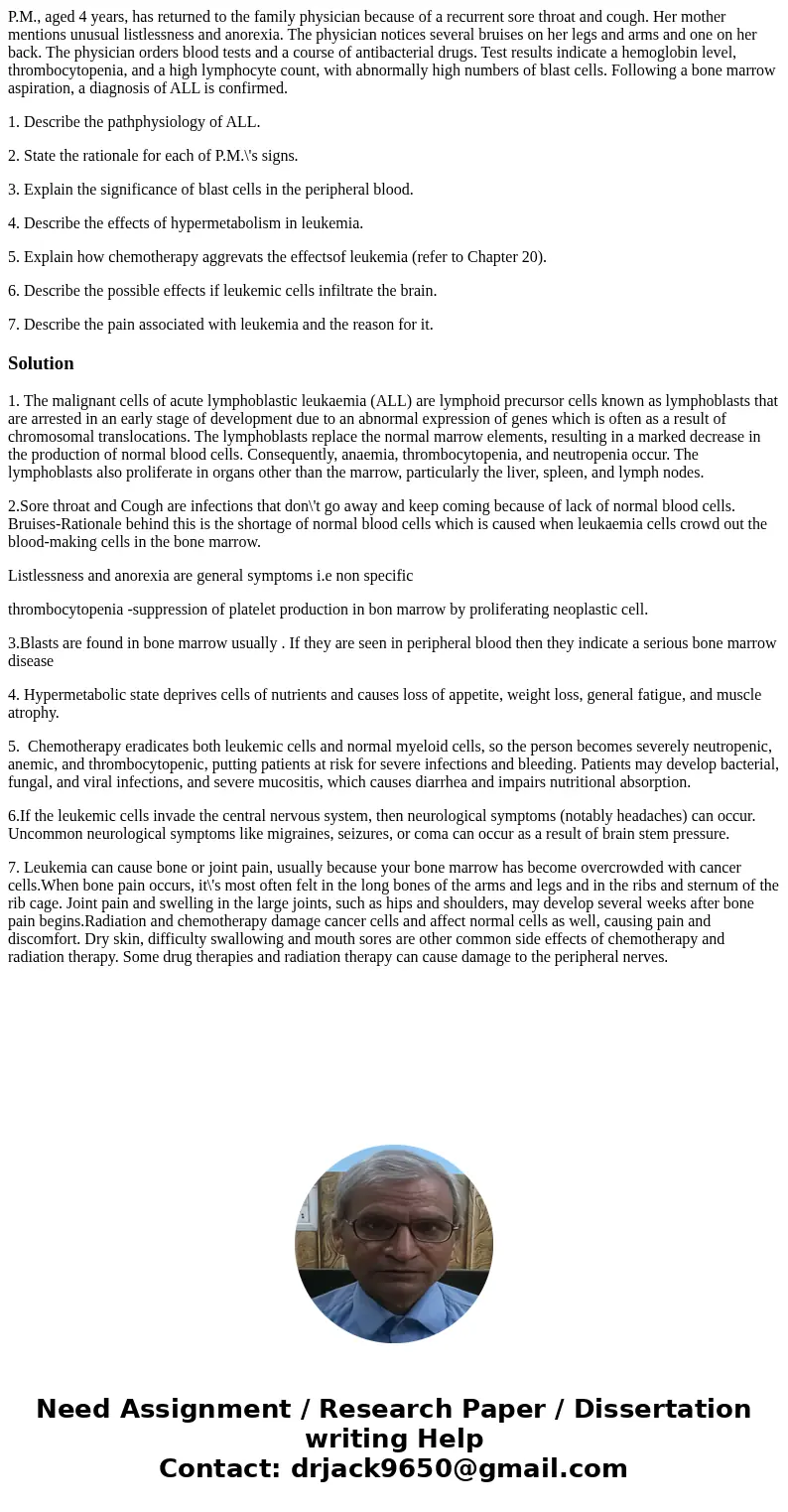PM aged 4 years has returned to the family physician because
P.M., aged 4 years, has returned to the family physician because of a recurrent sore throat and cough. Her mother mentions unusual listlessness and anorexia. The physician notices several bruises on her legs and arms and one on her back. The physician orders blood tests and a course of antibacterial drugs. Test results indicate a hemoglobin level, thrombocytopenia, and a high lymphocyte count, with abnormally high numbers of blast cells. Following a bone marrow aspiration, a diagnosis of ALL is confirmed.
1. Describe the pathphysiology of ALL.
2. State the rationale for each of P.M.\'s signs.
3. Explain the significance of blast cells in the peripheral blood.
4. Describe the effects of hypermetabolism in leukemia.
5. Explain how chemotherapy aggrevats the effectsof leukemia (refer to Chapter 20).
6. Describe the possible effects if leukemic cells infiltrate the brain.
7. Describe the pain associated with leukemia and the reason for it.
Solution
1. The malignant cells of acute lymphoblastic leukaemia (ALL) are lymphoid precursor cells known as lymphoblasts that are arrested in an early stage of development due to an abnormal expression of genes which is often as a result of chromosomal translocations. The lymphoblasts replace the normal marrow elements, resulting in a marked decrease in the production of normal blood cells. Consequently, anaemia, thrombocytopenia, and neutropenia occur. The lymphoblasts also proliferate in organs other than the marrow, particularly the liver, spleen, and lymph nodes.
2.Sore throat and Cough are infections that don\'t go away and keep coming because of lack of normal blood cells. Bruises-Rationale behind this is the shortage of normal blood cells which is caused when leukaemia cells crowd out the blood-making cells in the bone marrow.
Listlessness and anorexia are general symptoms i.e non specific
thrombocytopenia -suppression of platelet production in bon marrow by proliferating neoplastic cell.
3.Blasts are found in bone marrow usually . If they are seen in peripheral blood then they indicate a serious bone marrow disease
4. Hypermetabolic state deprives cells of nutrients and causes loss of appetite, weight loss, general fatigue, and muscle atrophy.
5. Chemotherapy eradicates both leukemic cells and normal myeloid cells, so the person becomes severely neutropenic, anemic, and thrombocytopenic, putting patients at risk for severe infections and bleeding. Patients may develop bacterial, fungal, and viral infections, and severe mucositis, which causes diarrhea and impairs nutritional absorption.
6.If the leukemic cells invade the central nervous system, then neurological symptoms (notably headaches) can occur. Uncommon neurological symptoms like migraines, seizures, or coma can occur as a result of brain stem pressure.
7. Leukemia can cause bone or joint pain, usually because your bone marrow has become overcrowded with cancer cells.When bone pain occurs, it\'s most often felt in the long bones of the arms and legs and in the ribs and sternum of the rib cage. Joint pain and swelling in the large joints, such as hips and shoulders, may develop several weeks after bone pain begins.Radiation and chemotherapy damage cancer cells and affect normal cells as well, causing pain and discomfort. Dry skin, difficulty swallowing and mouth sores are other common side effects of chemotherapy and radiation therapy. Some drug therapies and radiation therapy can cause damage to the peripheral nerves.

 Homework Sourse
Homework Sourse